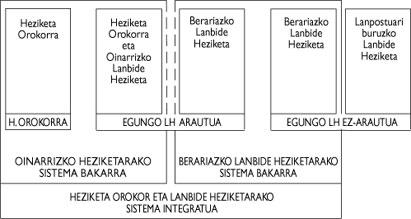Environmental Education in the System
1994/01/01 Alvarez, Josetxo | Fernández Quintela, A. | Martinez de Lagos, Kepa Iturria: Elhuyar aldizkaria
Since the sixties and seventies, human groups and conscientious movements have claimed the necessary political change to maintain the Planet in which we live, highlighting the problems of the limits of growth and development. Rethink the person/environment relationship.
Although the Educational System has sometimes forgotten the problems and approaches related to academic and everyday life, in search of this link with reality, in some cases it has already begun to relate to everyday life, the environment, the person and society.
This emphasizes the value of the environment, its knowledge and contact, because we can develop all our capacities in a more appropriate and effective way; the environment is a pedagogical resource that “exploits”.
But the challenge is not just about school, but about society as a whole. The task of sensitizing the new generation is attributed to the Educational System. On the other hand, I want to highlight two of the gaps that have, on the one hand, that with this policy, we ourselves, who deteriorate the environment day by day, have the excuse to continue the same, while now we continue to increase the damage, we leave the responsibility to apply the solutions for later and leave them behind. On the other hand, and to the extent that school is a reflection of society, we are faced with a purely cynical behavior, since the values and behaviors that we ask the school are contrary to those that prevail in all kinds of environments, at home, on the street, in the school community, in the media, etc.
Currently, within the Educational Reform, a model of integration of Environmental Education has been adopted: the model of transversal lines. From the society have emerged some of the needs and sensitivities that are currently collected in the section of Transversal Lines. Consequently, we want to review the Educational Function we want to achieve with this society, including the school, and within it also the relationship with the environment.
This model is fully consistent with the principles, methods and objectives of Environmental Education. The quality of life and the improvement of the environment are not topics that must be addressed in a discipline or area but learning experiences based on the style of teaching, lifestyle, use of resources and organization of spaces.
This model, in turn, leads us to agree with the lines across the other and to jointly construct a global thought to understand social problems.
Taking into account the perspective of global education and in order to enable coherence of objectives and means, actions for the development of Environmental Education would be:
- To remodel curricular contents, encouraging the interdisciplinary treatment of contents; explaining the human dependence of the environment; highlighting the relationships between the near reality and the distant environment and proposing actions in favor of the environment.
- Develop education for participation and social action, extend the school to society, working together with institutions, groups and social movements to improve the environment and quality of life.
- Reconversion of school collective life: remodeling external and internal spaces, reducing resource consumption and waste production and improving personal relationships and teaching methods.

Gai honi buruzko eduki gehiago
Elhuyarrek garatutako teknologia






